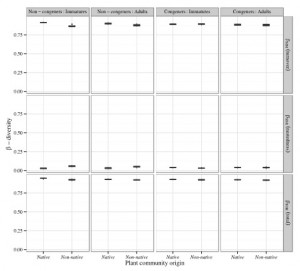Lots of discussion recently over on the Facebook side regarding the recent publication in Ecological Letters by Karin Burghardt and Douglas Tallamy, “Not all non-natives are equally unequal: reductions in herbivore β-diversity depend on phylogenetic similarity to native plant community.” http://onlinelibrary.wiley.com/doi/10.1111/ele.12492/full
While there are certainly some things to nitpick in the paper (see Linda’s comments on the Facebook discussion), I think this paper may go a long ways re-shape, and possibly even begin to end, the debate over native versus exotic.
How was the study conducted. In 2006 Tallamy’s group established a series of test landscape plantings. Each planting fell into one of four groups: non-native congeners (species that are not native but have native relatives in the same genus); non-native non-congeners (plants from non-native genera), native congeners and native non-congeners. In 2008, when the trees were about 6’ (1.8 m) tall, they conducted a census to identify and quantify the adult and immature insect herbivores they collected. They analyzed the data to determine the amount of insect herbivore diversity within each planting type. Specifically they looked at what ecologists refer to as beta-diversity, the amount of species diversity among sites. If you’re interested and want to learn more check out https://methodsblog.wordpress.com/2015/05/27/beta_diversity/
So, what did they find? Like every good study on host-insect interactions; the answer is, “It depends.” (BTW, if you’re following along at home the key figure in the paper is Fig. 3). When Burghardt and Tallamy looked at the differences in diversity between adult herbivores on native and non-native congeners, they found no difference. When they looked at differences in diversity between immature herbivores on native and non-native congeners, they found no difference. When they looked at differences in diversity between adult herbivores on native and non-native non-congeners, they found no difference. When they looked at immature herbivores on native and non-native non-congeners, they found a small but statistically significant difference, with higher total diversity for native non-congener.
As an aside, it is also instructive to look the version of Figure 3 presented in the article’s supplemental materials, which has been re-scaled to include zero. Including zero on the scale helps to give a better perspective on the actual variation among means. It’s a little like the “Truth in lending statement” that comes at the end of your credit card bill.
So, a possible alternative title for the paper could be, “Do native or non-native plants increase herbivore diversity? Most of the time it doesn’t matter.” That said, I think this paper makes a number of contributions and will start to shift native versus non-native debate, and perhaps even signal the beginning of the end. First of all it demonstrates that that non-native species of native genera contribute equally to herbivore diversity. However, I think some of the most insightful information in the paper is buried between the lines and in the supplemental information attached to the online version of the paper. The authors briefly mention that they also looked at guilds (i.e., chewing insects, sap feeding insect, xylem feeders, etc.). Once again the answer of whether natives contribute more to species diversity is, “It depends.” For xylem feeders, for example, diversity was the same for congeners and non-congeners.
To me, this is the level of resolution we need to work to gain a true handle on the situation. I’m not an entomologist and I’ve never played one on TV but I’ve been around these questions long enough to know that different types of insects are attracted to or repelled by different plants by different mechanisms. In one case it’s an attraction pheromone, in another it’s a defense chemical, sometimes it’s leaf toughness or a tree is able to produce enough resin to drown boring insects. An old axiom states that ecosystems are not more complicate than we think; ecosystems are more complicated than we can think. As this paper demonstrates, to think that all the complex interactions between plants and insects can be boiled down to something as simple as native or exotic is hopelessly naïve.

Is it different in Florida? I know it depends but stuff grows more vigorously in FL.
I think you may be thinking of invasiveness, Mary, which is different issue. The point here is that the diversity of insect herbivores that will use a plant is a function of the species and the degree of genetic isolation (does it have any local relatives?). Burkhadt and Tallamy are saying that non-native trees that come from genera which include native species, will support the same insect diversity as native species.
It’s a rather short term study to really say much about the shift in populations
As with any study, there are always things that could be done different or better. However the authors have made a reasonable attempt to keep this an apples to apples comparison.
It would be interesting to see a real world example where people buy what big box stores sell and plant 1 tree. And the home association all buys the same tree that is non native so the native competes with non native in a non 1:20 scenario. That’s a made up estimate built on what I see in my area.
Monocultures (and oligocultures) need to be avoided regardless of species provenance.